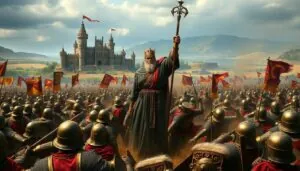In the world of real-time strategy games, few titles stand the test of time like Age of Empires II. Whether you’re a seasoned general or a fresh-faced villager, mastering the art of strategy in this classic can turn the tide of battle faster than you can say “build more farms.” With a plethora of civilizations and tactics at your fingertips, the challenge is not just to survive but to thrive and conquer.
Table of Contents
ToggleOverview of Age of Empires 2 Strategy
Mastering Age of Empires II strategy involves understanding key components, including economy management, military tactics, and unit composition. Players prioritize gathering resources efficiently, balancing food, wood, gold, and stone for advancement. Developing a robust economy forms the backbone of success, allowing for the consistent creation of military units.
Strategic planning in Age of Empires II also requires players to select appropriate civilizations. Unique units, technologies, and bonuses significantly differ among civilizations, influencing gameplay styles. For instance, the Britons excel in archery, while the Franks thrive with cavalry. Selecting the right civilization enhances tactical flexibility in various situations.
Early game strategies often focus on scouting opponents and gathering intelligence. Players scout to locate resources and identify potential threats. An early rush can destabilize an opponent’s economy and yield a significant advantage.
Mid-game tactics frequently emphasize transitioning from defensive to offensive strategies. Players often create a balanced army, combining infantry, archers, and siege equipment to enable effective assaults. It’s essential to adapt unit compositions based on the enemy’s defenses.
Late game strategies generally revolve around achieving technological supremacy. Upgrading units and researching critical technologies become vital to outmaneuver opponents. Additionally, players utilize map control to secure resources and establish forward bases, ensuring a strategic edge.
At any stage, effective communication in team games bolsters overall strategy. Coordinated attacks and shared resources can lead to overwhelming victories. Understanding these elements aids players in navigating the complex landscape of Age of Empires II and enhances their chances of success on the battlefield.
Key Gameplay Mechanics
Mastering key gameplay mechanics enhances performance in Age of Empires II. Understanding unit types and their roles, along with effective resource management techniques, significantly impacts strategy.
Unit Types and Their Roles
Infantry units excel in close combat situations. Archers provide ranged support, targeting enemy units from a distance. Cavalry units focus on speed and mobility, enabling quick flanking maneuvers. Siege weapons operate effectively for destroying buildings and fortifications. Each unit type contributes uniquely to battles, allowing for diverse strategies. Combining these units creates balanced armies capable of countering various threats. Understanding specific civilization bonuses, such as unique units, enriches tactical options. This knowledge empowers players to adapt strategies for different situations.
Resource Management Techniques
Gathering resources requires efficiency and planning. Players must prioritize food, wood, gold, and stone based on strategy and civilization needs. Setting up multiple town centers improves villager production, increasing resource collection rates. Building farms ensures a steady food supply for unit training. Market utilization allows trading excess resources for needed ones, enhancing flexibility. Upgrading technologies improves gathering efficiency and unit production speed. Players often scout opponents to anticipate resource needs, allowing timely adjustments. Effective resource management directly affects army composition and technological advancement.
Strategies for Different Civilizations
Different civilizations in Age of Empires II provide unique strategies based on their strengths, weaknesses, units, and technologies. Understanding these factors helps players excel in each game.
Strengths and Weaknesses
Each civilization has distinct advantages and vulnerabilities that shape gameplay. For instance, some civilizations possess strong infantry, enabling aggressive early-game strategies, while others focus on economy, enhancing resource production. Knowing the strengths allows players to capitalize effectively on their civilization’s unique traits. Conversely, recognizing weaknesses informs defensive strategies against threats. An aggressive civilization can dominate early on, but if outmatched late game by a technology-focused civilization, it may struggle.
Unique Units and Technologies
Unique units play a crucial role in defining civilizations in Age of Empires II. Each civilization receives a special unit that can turn the tide in battles, such as the Frank’s thrown siege equipment or the Mongol’s fast cavalry. Technologies also provide unique advantages; for instance, the Byzantine’s powerful defensive structures enhance survivability. Leveraging unique units and technologies leads to tailored strategies that exploit the civilization’s potential, enhancing overall effectiveness in combat. Thus, players gain an edge by understanding and utilizing these features strategically.
Common Tactical Approaches
In Age of Empires II, players employ various tactical approaches to secure victory. Mastering both offensive and defensive strategies greatly enhances gameplay effectiveness.
Offensive Strategies
Players often prioritize aggressive tactics to unsettle opponents early. Rushing techniques, such as the Scout Rush or Archer Rush, exploit opponent weaknesses before defenses strengthen. These strategies take advantage of faster unit production to maintain constant pressure. Additionally, using siege weapons can efficiently dismantle enemy structures, creating openings for infantry and cavalry to exploit. Combining unit types, like mixing infantry with cavalry, creates diverse threats that keep enemies on guard. Scouts play a vital role in gathering intelligence about enemy placements and expansions, allowing players to adapt their tactics swiftly.
Defensive Strategies
Building a solid defense forms a crucial part of gameplay. Players often focus on walling off key areas to control movement and ensure resource safety. Towers provide excellent protection while doubling as production points for defense units. Prioritizing economy management enables players to create a balanced army capable of withstanding enemy assaults. Maintaining awareness of the map and scouting constantly helps players anticipate enemy attacks and adjust their defenses accordingly. Investing in upgrades, including unit armor and technologies, further bolsters defenses, preserving valuable forces for counter-offensives.
Advanced Strategies for Competitive Play
Mastering advanced strategies in Age of Empires II enhances competitive gameplay. Players focus on various aspects to establish dominance, including economy efficiency, troop diversity, and tactical deployment.
Gathering resources efficiently underpins economic strength. Setting up multiple town centers accelerates unit production. Players must construct buildings in optimal locations to access resources quickly, ensuring a balanced economy for military development. Prioritizing upgrades provides technological advantages that can shift battles.
Unit composition plays a pivotal role in strategy. Mixing infantry, cavalry, and siege units creates a versatile army capable of countering diverse threats. Employing archers in combination with infantry can preserve frontline strength. Cavalry excels at flanking, while siege units wreak havoc on enemy defenses.
Map control is another critical focus. Dominating key locations secures vital resources and obstructs enemy movements. Players benefit from regularly sending units to scout their opponents, gathering vital intelligence on enemy strategies and troop compositions. This knowledge aids in adjusting tactics to exploit weaknesses.
Timing is crucial when launching attacks. Coordinated assaults with multiple groups can overwhelm defenses, forcing opponents to react under pressure. Aggressive strategies like Forward Base techniques can disrupt enemy economies early, while maintaining a strong defensive posture counters potential retaliations.
Flexibility remains essential in gameplay. Adapting strategies in response to opponents’ moves ensures relevance throughout the game. Utilizing effective communication in team matches amplifies strategy execution, as players coordinate attacks and defenses seamlessly.
Ultimately, consistent practice with nuanced strategies influences victory rates. With a comprehensive understanding of civilization traits, unit roles, and advanced tactics, players position themselves for success in Age of Empires II.
Conclusion
Mastering strategy in Age of Empires II requires a blend of tactical knowledge and adaptability. Players must understand their civilization’s strengths and weaknesses while efficiently managing resources to build a formidable economy.
Effective unit composition and the ability to switch between offensive and defensive tactics are crucial for gaining the upper hand in battles. With practice and a keen awareness of the game mechanics players can refine their strategies and enhance their gameplay experience.
By embracing diverse tactics and continually adapting to opponents players can ensure they’re always one step ahead in the quest for domination in this classic real-time strategy game.








